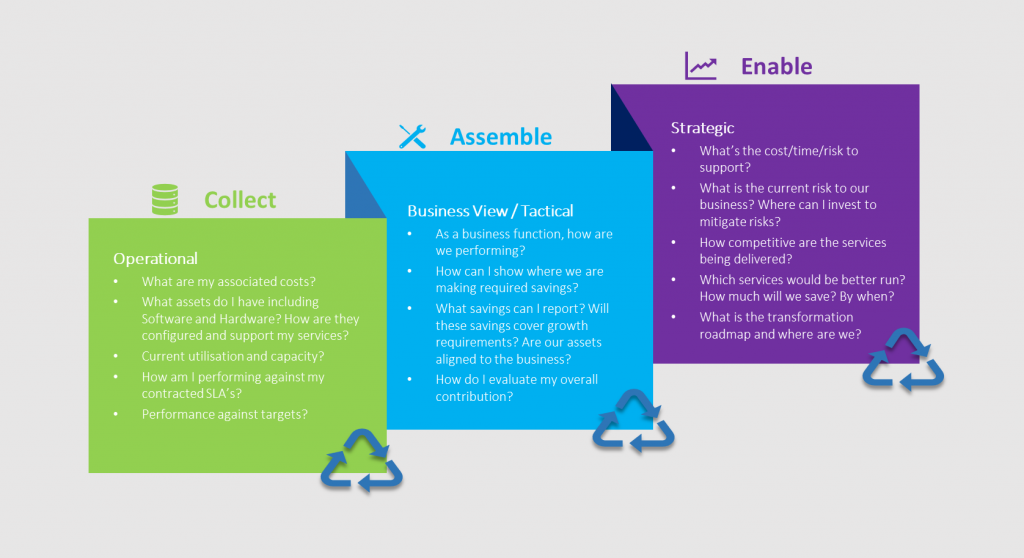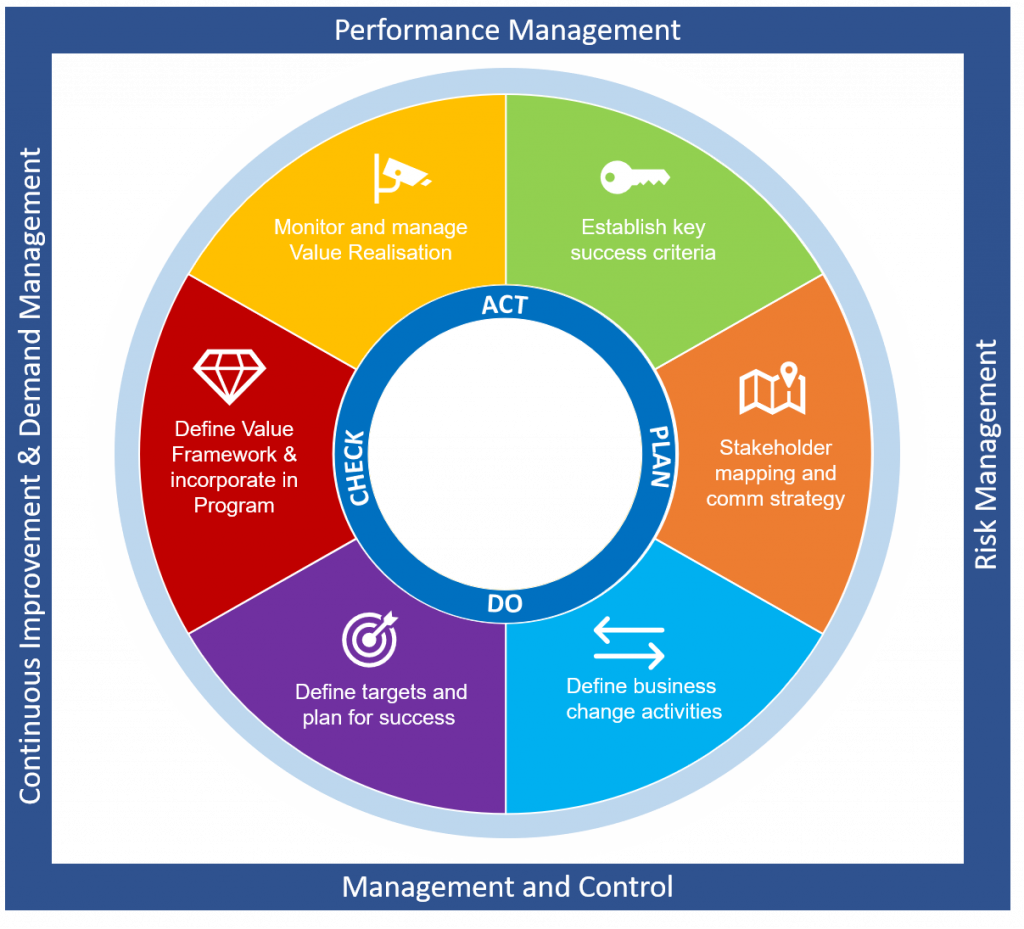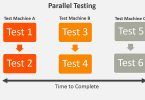Why do we need to bother about value realization?
Achieving the business case on which you based your decision to invest in new capabilities and the technology to enable them doesn’t happen automatically. The business case, your vision, and desired outcomes are key inputs to develop the strategy for your investment. Typically, organizations start with the right intention in getting the sponsorship and articulating the end goal. This is handed over to the project team to implement the solution. The project team’s primary focus is to deliver the functionality to the agreed schedule, cost, and quality rather than delivering to the benefits and business outcomes. There are many common challenges and risks that result in not realizing the vision and business benefits. Some examples include:
- Organizations don’t plan effective business change activities resulting in poor operational readiness to adopt new ways of working;
- End-users typically don’t adopt new processes; use workarounds rather than accept new tools/methods;
- Poor governance, communication and controls impacts the adoption and realization of value;
- Operational efficiencies not achieved when solution capability is not exploited; processes, roles and solution misaligned;
- Lack of engagement with solution providers to leverage their experience and good practices.
To ensure that your project achieves more of the benefits and value outlined in your business case, you need a solid focus on value realization. Now that you know why value realization is critical to the success of your technology investments, this blog will go into the “what” and “how” of delivering greater value realization at your company.
What needs to be done to support the realization of value in your investment?
As you can tell, managing the realization of your goals aligned to your investment in technology will depend on several key elements to be successful: defining the success criteria with clear goals, specific and intentional execution against a well-defined approach, a way to measure achievements, monitoring outcomes, and taking the appropriate steps to address deviations. This must be reinforced by an effective governance structure that will facilitate and coordinate stakeholders to support the alignment to common business goals.
Key aspects of effective governance are the ability to make the correct decisions and escalate if required. This needs to be underpinned by a performance management system that will support the measurement and monitoring of benefits. After all, if you can’t measure, you can’t manage, and if you don’t manage, you won’t achieve.
Your performance management approach needs to be flexible to address different benefit outcomes based upon stakeholder groupings. At the operational level, the focus should be on efficiency of the delivered services. At the business level, the focus should on the effectiveness. At the strategic level, the focus should support the changing business priorities. That said, below are examples of metrics that will be important for the business to consider:
- Efficiency. This will measure productivity. This is about doing the same with fewer resources which enables the excess to be released or moved to other value-adding activities.
- Effectiveness. This will measure the quality of the service and user experience. It is about making resources more effective by doing a better job than the one performed before.
- Strategic. This will measure growth and exploitation of opportunities and agility as well as flexibility in supporting changing business priorities.
Below is an example of decisions required to support the management and reporting of outcomes across all layers of the organization.

Figure 1: Performance Management is informed by the decisions around the questions represented in the above figure.
Now that it is clear what goes into and informs value realization and the different levels of metrics that will be important to measure, next let’s get into how this is put together into a plan for value realization and critical outcomes.
How do we plan the realization of value and outcomes?
Managing the realization of value requires a comprehensive and holistic approach. This should encompass planning your investment as well as managing and implementing the new capabilities through to continuously monitoring and validating achievement of your target outcomes and values. It is equally important to ensure the sustainability of the investment which means managing future demand and driving continual service improvement activities. Figure 2 below provides an overview of BMC’s approach to help customers with the realization of the objectives and goals of their investment decisions.

Figure 2: BMC’s value realization and business change activities alignment
BMC’s comprehensive approach to value realization helps with managing business change and is integrated with the enablement of the technical capabilities. This requires establishing the critical success factors for achieving the goals and realization of the vision. These are typically based on three important criteria: improved productivity, better-quality service delivery and enhanced user experience. To begin making progress on these important criteria, first identify impacted stakeholders and develop a communication strategy for managing expectations and adoption. Next, determine and incorporate the business change activities that will be part of the overall program plan. For example, these could be related to process optimization, enhancing staff capabilities or strengthening governance and control. Additionally, you will need to outline the benefits, metrics, baseline data, benefit owners, targets, and dependencies as well as align them to the program schedule. Lastly, you will need to measure and monitor outcomes as well as identify deviations. When deviations are found, it will be vital to take actions that define the mitigation steps necessary to address potential risks for not realizing the target outcomes.
These activities must be supported by an effective performance management system that reports outcomes, monitors performance, and manages the risk of failing to achieve and realize the value and outcomes from your investment. That requires implementing a process for managing demands and continual service improvements to ensure business alignment. All this must be underpinned by an effective governance and control regime that coordinates a diverse range of stakeholders to address potential resistance to change and realize the desired outcomes and value.
As you can see from the why, what, and how described above, value realization requires effective governance, performance management, and consistent communication of progress and mitigation to stay on track. With successful realization of the benefits and outcomes from your technology investment and its contribution to enabling business priorities, this will increase the confidence and credibility in IT from the business community. Additionally, it will provide better understanding and justification of the investment decision in terms of what has really been achieved with the right level of governance and oversight. The value realization activity will increase solution adoption and exploitation. It will also minimize the need for customizations, resulting in adoption of good practices that deliver a lower cost of ownership, and better alignment to your technology supplier’s product roadmap. Moreover, the value realization activities described above will support key ITIL 4 principles to enable a service value system (SVS) that embraces an end-to-end ecosystem for value creation through products and services as well as incorporates a service value chain model that supports a flexible operating structure.
If you need assistance with developing a value realization approach aligned to your technology investments, please fill out our form and a BMC Customer Success expert will reach out to get started.







